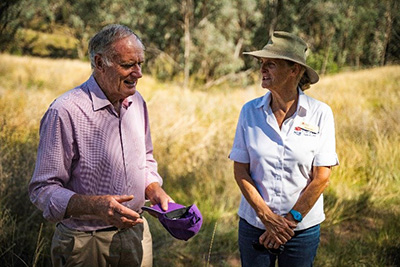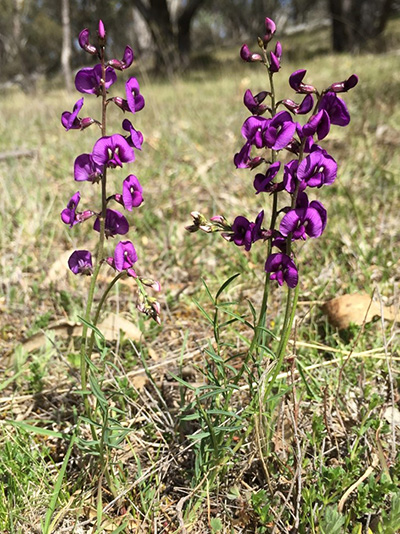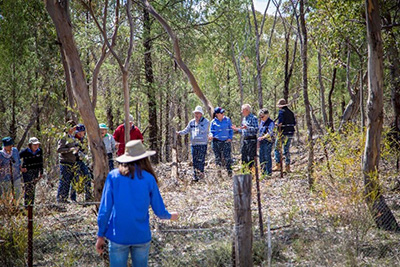Case study: Expanding the reach of the Small Purple-pea – Richard Ivey
Introduction
After the Small Purple-pea (Swainsona recta) was discovered on a small section of their property, Jo and Richard Ivey agreed to participate in a project supported by Central West Local Land Services.
A 7ha area containing the endangered plant was fenced out, and an alternate watering point was installed outside the protected area.
Outside of their busy professional lives, Jo and Richard live on and manage the 111ha property called “Limestone” near Mount Arthur Reserve to the west of Wellington in Central West NSW.
Formerly stocking sheep, the Ivey’s bought Limestone in 2011 and began stocking breeding cows instead to limit grazing pressure. When a friend discovered the Small Purple-pea on their property in 2018, Jo and Richard contacted Local Land Services for assistance. After learning more about what funding was available, and about the unique position they were in to help this nationally endangered plant, Jo and Richard jumped at the opportunity to help protect the species.

Richard Ivey with Libby McIntyre, Local Land Services.
Challenge
After the Small Purple-pea was discovered, the challenge was to figure out exactly how to protect it while preventing any impacts on the productivity of the Ivey’s farm. This was at the height of the drought and they had already begun destocking their breeding cattle.
The Ivey’s had concerns about restricting stock access to part of the property which might affect future grazing productivity. Fortunately, the Small Purple-pea was found predominantly in a steep outer part of the Ivey’s acreage that had not been grazed for some time.
“We located the pea and were a bit lucky in the sense that it was towards the south-eastern corner of the property. It would be quite easy to fence off the southern bit of the property. About 7 hectares was fenced out from grazing and now protects the population. It hasn't really disrupted the overall management or layout of the property itself,” said Richard.
Protection for the Small Purple-pea
The works undertaken by Jo and Richard with Central West Local Land Services included surveying, researching and planning where to fence, where the new watering point would be located and discussions about ongoing weed and pest animal management. Conventional hinge-joint fencing with a top plain wire, was erected by local contractors taking around 3 months to complete due to wetter conditions than usual.
The new Small Purple-pea reserve is designed to restrict stock access, but two gates were installed to allow for intermittent 2-3 day crash grazing/fuel reduction when the pea is semi-dormant and access for weed control and pest animal management.
Funding was used for:
- fencing materials
- new trough and piping
- pest animal and weed control over the 10-year contract e.g., goats.
Other benefits from fencing the area have included:
- increased biodiversity
- a greater understanding of protecting an endangered species
- flow on effects across the property i.e., educed erosion
- minimal grazing by native and feral herbivores.
“This endangered species has given us the opportunity to do something really important by preserving and enhancing this species. If we selectively crash graze at the right time of the year, as part of the agreed management program we will do so. But the ability to be able to protect and nurture and hopefully re-establish the species is fantastic,” said Richard.

Small Purple-pea in flower.
Results, growth and positive long-term effects
The installation of the fencing in combination with Richard and Jo’s decision not to graze in this area for some years has seen an increase in numbers of Small Purple-pea plants with the plants thriving from excellent growing conditions.
The plants have survived in often extremely dry conditions but have the advantage of an extensive tap root system (up to 1.5m in some cases). By prioritising the ecology on just a small part of their property, restricting stock access to roughly 10% on some of their least grazeable land, the Ivey’s have seen widespread positive knock-on effects to the ecosystem of the entire property.
Hear from Jo and Richard Ivey
Protecting the Small Purple-pea
The Central West Local Land Services region contains important habitat for the critically endangered Small purple-pea (Swainsona recta).
Once widely spread across eastern Australia, individual plant numbers have reduced significantly from the original range that the species has an endangered conservation status at both a state and federal level. The remaining population base exists around Wellington in the Central West region, locations around Mudgee and Mandurama in the Central Tablelands region and small areas surrounding Queanbeyan.
Central West Local Land Services has collaborated with Central Tablelands Local Land Services, Office of Environment, Energy and Science, land managers and other key stakeholders to address and implement recommendations from the National Recovery Plan for the Small Purple-pea. This includes:
- protection and enhancement of critical habitat through on ground works and
- increasing community awareness of the species.
Ongoing protection, management and recovery of remnant vegetation on private land is crucial to the future survival of this unique species. Priority areas have been identified across the Central West region with recommended activities to support and increase the connectivity and condition of significant habitat. There is a particular focus on projects that occur in areas of habitat known to support the Small Purple-pea and include Grassy Box Gum Woodlands- commonly White Box, Yellow Box and/or Blakely’s Red Gum.
“It might be the Small Purple-pea, it might be a frog, it might be some insects, it might be some other species, it could even be some animals… just the awareness that, ‘hang on, we don't just have to put fences around a property and run cattle or sheep or crop inside it… We've got to be aware of the much bigger picture and a project like this certainly brings that thought to the fore. You know, it really does highlight what is important other than just growing more wool or fattening more cattle,” said Richard.

A group event for the Small Purple-pea.
Funded by
This project is supported by Local Land Services, through funding from the Australian Government’s National Landcare Program.
For more information
Contact your nearest Local Land Services office on 1300 795 299.